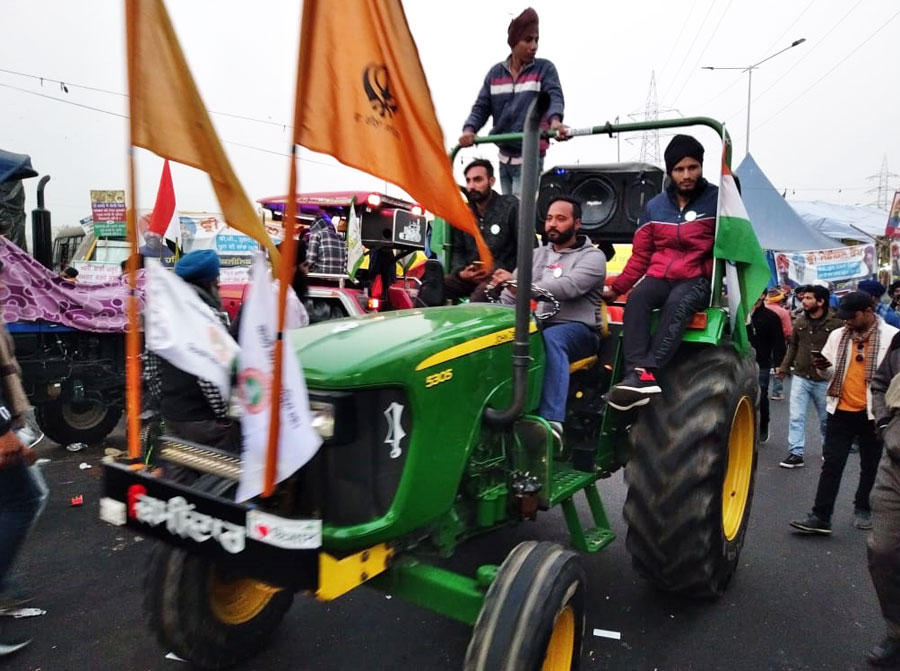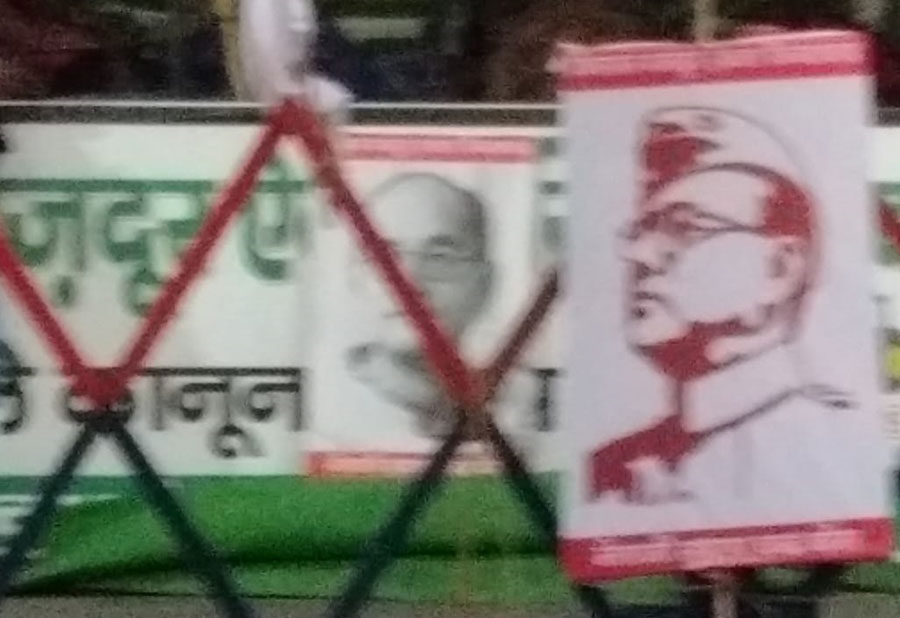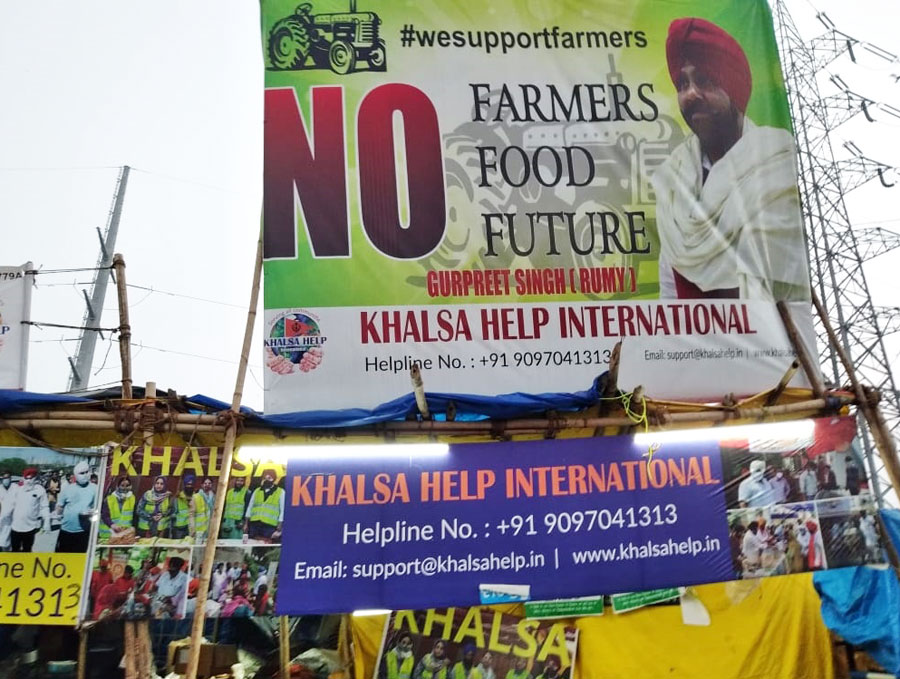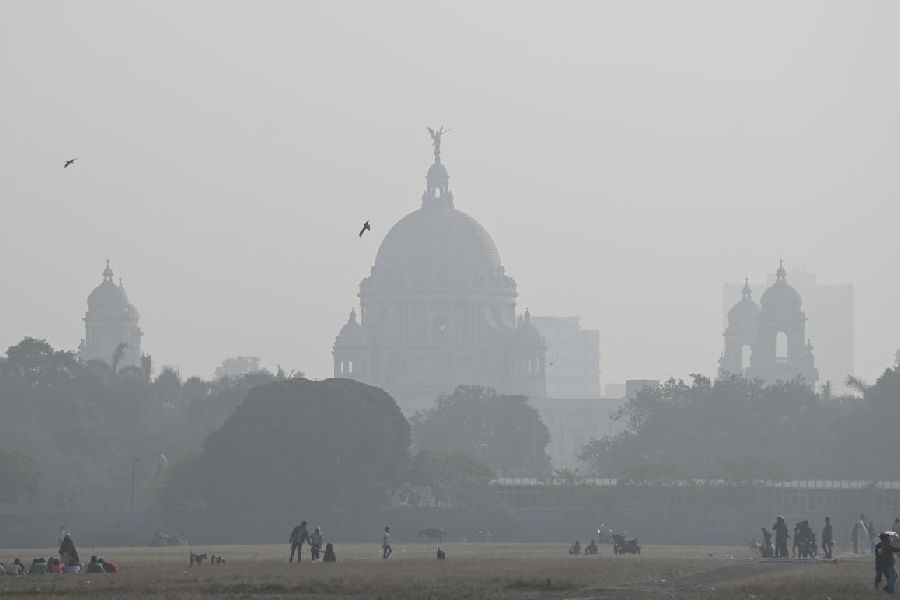A balloon has gone up. It can be seen from kilometres to the east and the west. To the west is the Indian capital, Delhi. To the east is the state of Uttar Pradesh.
At the point where the balloon is tethered, Ram Charan Tripathi, a farmer and farm worker (labourer), is sitting on a separator on the Expressway – South Asia’s widest – and he is telling The Telegraph Online on Saturday evening that he lost his son on November 2 (2020).
Ram Charan Tripathi says he is 78 years old. Weatherbeaten face, red turban, a bristly grey moustache, a grey stubble on sunken cheeks. “I had three sons. Now I have two”, he says. “Sukesh died on November 2nd. I am here since November 28. I have an acre-and-a-half of land that was to be divided among them.”
The conversation is disturbed by a tractor with blazing lights and a Punjabi rap blaring over loudspeakers. It is driving up the flyover from the UP side.

A tractor makes its way through the protest site at Ghazipur. Sujan Dutta

At the Ghazipur protest site, farmers remember Netaji on his 125th birth anniversary. Sujan Dutta
“I cannot afford a tractor. So, the first time I walked here”, Ram Charan says. “I have been back home twice since I first came here. Kheti bhi toh karni hain.” (I also need to farm).
The tractor with blazing lights and stereophonic music is not what he has. Ram Charan reaps a harvest, at most, of 20 quintals of wheat from his farm. Last year, the government-ordained minimum support price (MSP) for it was Rs 1,868 per quintal.
He has to hire a tractor to churn the soil, hire a submersible pump to irrigate the land from a neighbor at a rate of Rs 150 per bigha. His land totals about 10 bighas. That makes it Rs 1500. He has to do it at least four times in the Rabi season to sow. These last few weeks, the unseasonal winter-rain were a relief. It spared him a round.
In addition, he has to pay for urea, the fertilizer, and for pesticides. The shrunken man on the UP –Delhi border tells me that in the Rabi season he has to spend about Rs 31,000 to reap 20 quintals of grain (wheat). But because the government has not granted the MSP of Rs 1,868 per quintal, and has reduced it by Rs 125, he will make only Rs 35,000.
“In all my life, I have never been free from debt”, he says.
Even Brahmins feel pangs of hunger. Ram Charan Tripathi is clearly a Brahmin, the elite in the hierarchy of the Hindu caste hierarchy. His village Shailendranagar in Gosai block of Amroha district is a mix of prosperous Jat and poor farmers. To make up for the rest of the year, he also works in the lands of the prosperous farmers – the ones who are here with stereophonic tractors – at the rate of Rs 300 per day – the mandated daily wage.

Banners at the Ghazipur protest site. Sujan Dutta
“Why do you think the people of Eastern UP and Bihar are not able to come here? It is not only because the trains are not running as they should. It is because the labour is rarely getting Rs 100 per day,” Ram Charan explains.
He is sitting on a separator on the Delhi-Meerut Expressway. “Wahan jaiye”, he waves to his right. “Dekhiye Dilli sarkar kya kar rahin hain. (Go see what the government in Delhi is doing).”
This is what the Government of India seated in New Delhi is doing:
On the flyover that connects UP with the national capital this evening, January the 23rd, a remarkable date because it is the 125th anniversary of Subhas Chandra Bose that the farmers here are observing, there are barricades being put in place by the Delhi Police. The Delhi Police is doing it on orders from the Union home ministry, not the government of Arvind Kejriwal who is the supposed chief minister of Delhi.
The barricade here, as we walk to the top of the flyover, is 1,400 paces in width. It is layered from east to west with concrete blocks that the Delhi Police sub-inspector who stopped me from taking pictures described as “stone pillars”.
They are actually concrete blocks. Their purpose is to separate the Expressway lanes from the service lanes. Each concrete block is four feet in height and five feet in length. I measured them. They are being put in place horizontally across the road. They were meant to be put horizontally in a longitudinal manner. Two cranes lift each block and place them at the point the Delhi Police marks with limestone chalk.
India’s capital is safeguarding itself from the country it headquarters.
Under the flyover is the camp of the Bharatiya Kisan Union (BKU) leader Rakesh Tikait, a son of Mahendra Singh Tikait (who led a farmers’ movement to New Delhi in 1988). The BKU has many factions. There is a buzz that the Centre may permit the Kisan Tractor Rally on January 26, India’s Republic Day (the day in 1950 when its Constitution was adopted). As it turns out later in the evening, the farmers’ front has put out a press release that tractor rally scheduled for the 26th has been given conditional permission by the Delhi Police.
On the flyover, Bhanu Pratap Singh, a lawyer who leads separate faction of the BKU, says diesel prices are soaring. He is suited, booted and wears a tie. He is usually primed to address a dress circle of cameras and microphones.
Under the flyover, in a service lane, pakodas (fritters) are being fried – one Sardar from Pilibhit (Maneka and Varun Gandhi’s constituency) on the Uttar Pradesh-Uttarakhand border – says “Modiji, isi ko GDP growth maante hain (Modi thinks this is economic growth)” – a reference to when the Prime Minister said in 2017 that streetside hawkers are also engines of economic growth.
In the time between last week and now, the length of the protest encampment in Ghazipur on the UP-Delhi border has more than doubled. In the women’s quarters marked with yellow tarpaulins and a poster, Harinder Singh says she has no issues coming on camera after the regulation evening check.
“We have laid out mattresses for 250 women. Because it is cold, we thought people will keep warm despite Corona (the virus). But it looks like we should have thought for 500”.
Women are queuing up in the storefront cut into an edge of a yellow tent where everything is being sold of a Rs 2 donation. Those who cannot afford to donate are told they can take what they want, free of cost.










